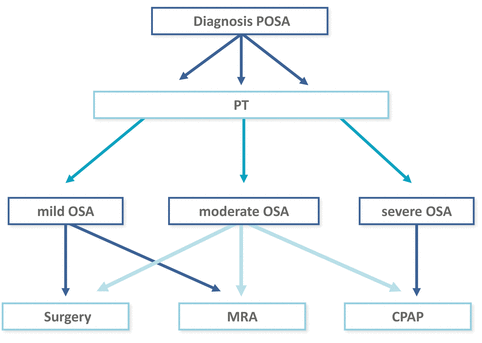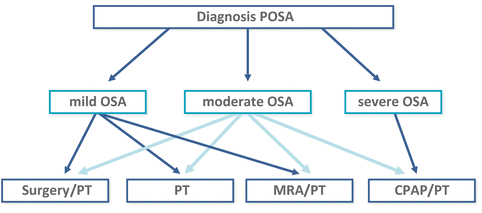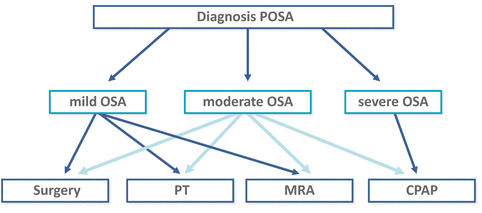Fig. 1
Recommendations of the current Dutch guideline
Patients with severe OSA are recommended to be treated with CPAP, whilst in moderate OSA, MAD or surgery can be considered as well. In patients with mild OSA, CPAP is regarded as overtreatment, especially since evidence suggests that CPAP compliance is reduced considerably in case of mild disease and minor symptoms. MAD or surgery is recommended as an alternative. Choice of treatment depends on patient characteristics, OSA severity, sleep position dependence, co-morbidity, health insurance coverage and patient preference, for instance.
What are the implications for more widespread use of PT for such flow charts? Several possibilities are demonstrated in Figs. 2, 3 and 4.



Fig. 2
Alternative is to start with PT, reassess the severity of the disease after PT and subsequently reconsider the treatment options

Fig. 4
Shows the situation in an ideal world, in which insurance companies cover multimodality/combined treatment, if indicated
Figure 2 shows an alternative treatment strategy for patients with POSA, by starting with PT followed by a reassessment of the severity of disease after initiation of treatment and subsequent reconsideration of treatment options. Some cases might be cured by PT alone: a reduction of the AHI to below 5. Whilst PT may result in a reduction in OSA severity in others: from moderate to mild OSA or from severe to moderate OSA, for example. By lowering the OSA severity category, patients could be eligible for less aggressive primary therapy (for example, lower CPAP pressure, less invasive surgery), especially since PT is simple, cheap, well tolerated and reversible. It would be important to accurately identify candidates who will benefit from a clinically significant improvement of their ORA with PT, suing the Amsterdam Positional OSA Classification, for example [10].
Stay updated, free articles. Join our Telegram channel

Full access? Get Clinical Tree







